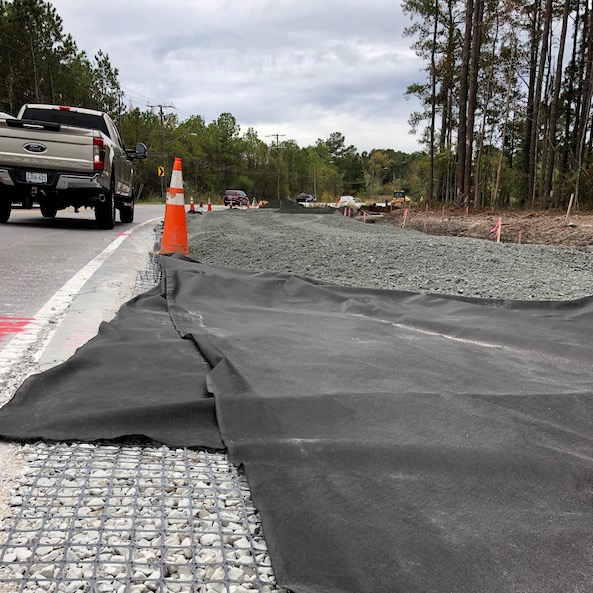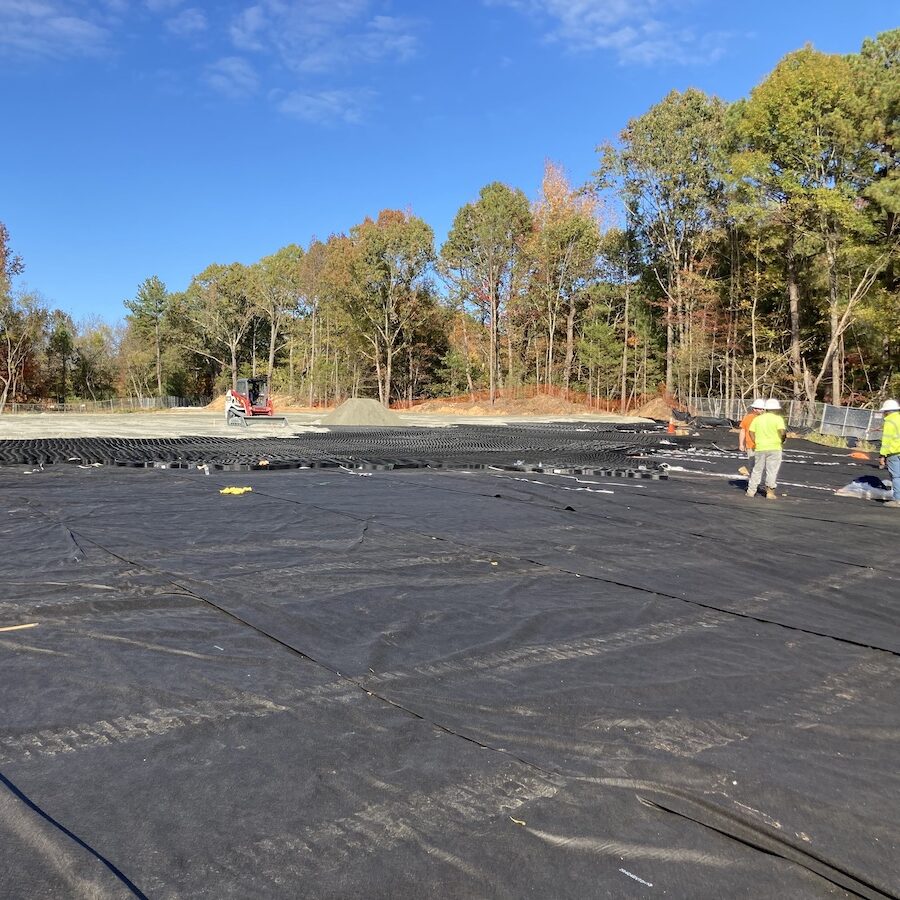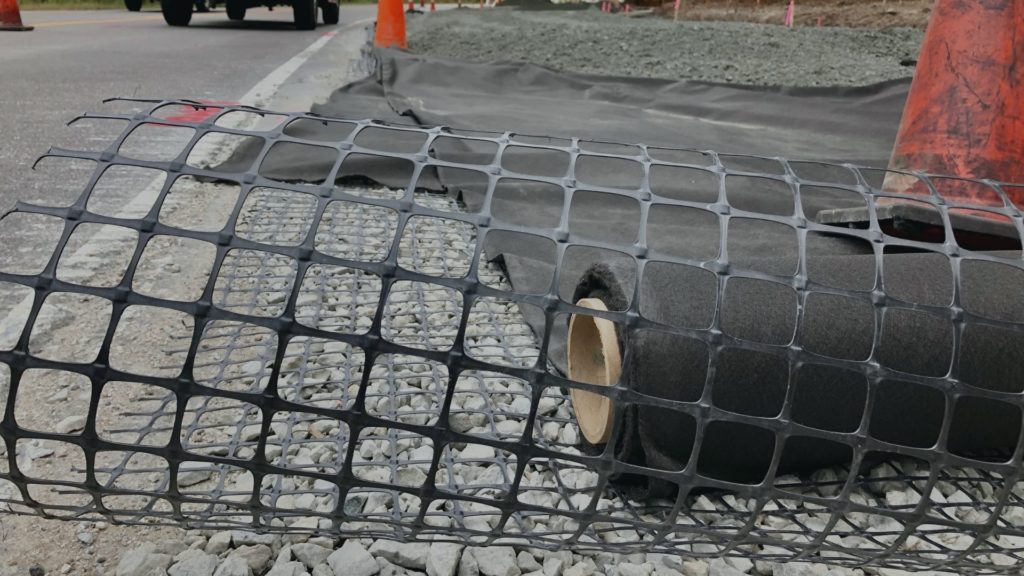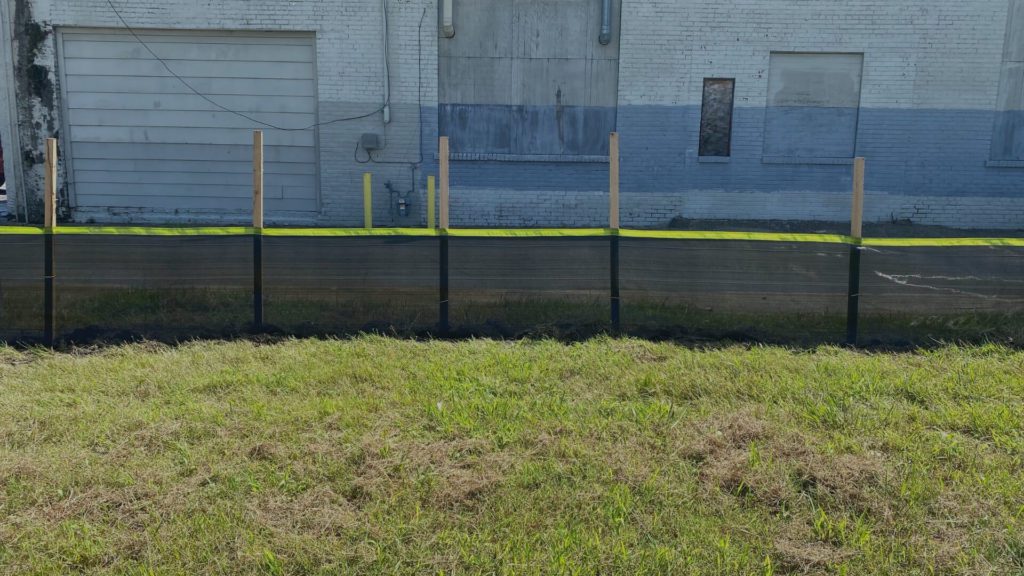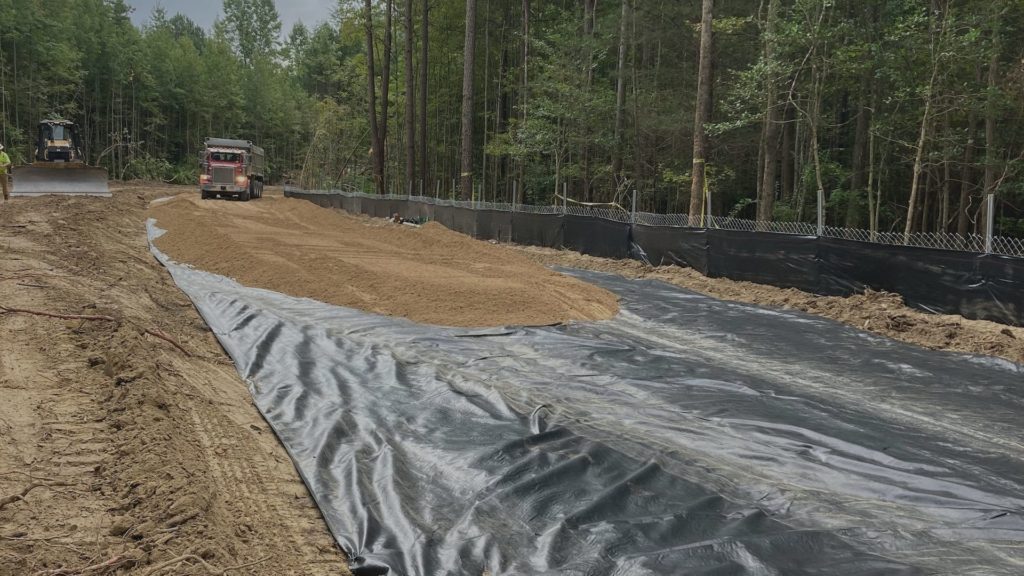Nonwoven Geotextile Fabric
A Nonwoven Geotextile Fabric is a permeable fabric that separates poor soils, provides high flow, and at certain strengths stabilizes the subgrade. A needle punch nonwoven geotextile is made from polypropylene fiber and has a felt-like texture. Nonwoven geotextiles are also known as filter fabrics and drainage fabrics.
Lightweight nonwoven geotextiles are most commonly used as a drainage and separation layer. Typical applications include pipe wrap on road and utility projects, filter fabric for landscaping projects and drainage fabric for retention and detention systems. These geotextiles range from 3.0 ounces to 4.5 ounces.
| Test Method | GT135 (MARV2) | GT140 (MARV2) | GT142 (MARV2) | |
|---|---|---|---|---|
| Grab Tensile Strength | ASTM D 4632 | 90 lbs | 100 lbs | 120 lbs |
| Grab Elongation | ASTM D 4632 | 50% | 50% | 50% |
| Trapezoid Tear Strength | ASTM D 4533 | 40 lbs | 45 lbs | 50 lbs |
| CBR Puncture Resistance | ASTM D 6241 | 265 lbs | 300 lbs | 340 lbs |
| Water Flow4 | ASTM D 4491 | 150 gpm/sf | 140 gpm/sf | 135 gpm/sf |
| Permittivity4 | ASTM D 4491 | 2.0 Sec-1 | 2.0 Sec-1 | 1.7 Sec-1 |
| AOS3&4 | ASTM D 4751 | 50 US Sieve | 70 US Sieve | 70 US Sieve |
| UV Resistance | ASTM D 4355 | 70% / 500 hrs | 70% / 500 hrs | 70% / 500 hrs |
1. The property values listed above are subject to change without notice.
2. Minimum Average Roll Values (MARV) is calculated as the average minus two standard deviations.
Statistically, it yields approximately 97.5% degree of confidence that any samples taken from quality assurance testing will meet or exceed the values described above.
3. Maximum Average Roll Value (MaxARV)
4. At time of manufacturing. Handling may change these properties.
Medium weight nonwoven geotextile fabrics are used for drainage, separation and stabilization. These fabrics have a greater tensile strength than the lightweight fabrics but lower permittivity. That means they are stronger than the lightweight geotextiles but not as permeable.
A medium weight nonwoven fabric is a great drainage layer for separating soils. When used for separation, medium weight geotextiles prevent contamination between soil layers while still allowing water to pass through the subgrade. This group of geotextiles is often used in combination with a geogrid to achieve maximum stabilization and separation on unstable subgrades.
| Test Method | GT160 (MARV2) | GT170 (MARV2) | GT180 (MARV2) | |
|---|---|---|---|---|
| Grab Tensile Strength | ASTM D 4632 | 160 lbs | 180 lbs | 205 lbs |
| Grab Elongation | ASTM D 4632 | 50% | 50% | 50% |
| Trapezoid Tear Strength | ASTM D 4533 | 60 lbs | 75 lbs | 85 lbs |
| CBR Puncture Resistance | ASTM D 6241 | 410 lbs | 475 lbs | 535 lbs |
| Water Flow4 | ASTM D 4491 | 110 gpm/sf | 105 gpm/sf | 95 gpm/sf |
| Permittivity4 | ASTM D 4491 | 1.5 Sec-1 | 1.4 Sec-1 | 1.4 Sec-1 |
| AOS3&4 | ASTM D 4751 | 70 US Sieve | 70 US Sieve | 80 US Sieve |
| UV Resistance | ASTM D 4355 | 70% / 500 hrs | 70% / 500 hrs | 70% / 500 hrs |
1. The property values listed above are subject to change without notice.
2. Minimum Average Roll Values (MARV) is calculated as the average minus two standard deviations.
Statistically, it yields approximately 97.5% degree of confidence that any samples taken from quality assurance testing will meet or exceed the values described above.
3. Maximum Average Roll Value (MaxARV)
4. At time of manufacturing. Handling may change these properties
Heavyweight nonwoven fabrics act as a soft separating geotextile layer between rough aggregate and other geosynthetic structures. The felt-like fabric provides protection for sensitive structures such as geomembranes and liners that can be compromised if they are punctured, ripped or torn. Heavyweight nonwoven fabrics are also applied for stabilization under roadways.
| Test Method | GT110 (MARV2) | GT112 (MARV2) | GT116 (MARV2) | |
|---|---|---|---|---|
| Grab Tensile Strength | ASTM D 4632 | 250 lbs | 300 lbs | 380 lbs |
| Grab Elongation | ASTM D 4632 | 50% | 50% | 50% |
| Trapezoid Tear Strength | ASTM D 4533 | 100 lbs | 115 lbs | 145 lbs |
| CBR Puncture Resistance | ASTM D 6241 | 700 lbs | 850 lbs | 1080 lbs |
| Water Flow4 | ASTM D 4491 | 80 gpm/sf | 75 gpm/sf | 50 gpm/sf |
| Permittivity4 | ASTM D 4491 | 1.2 Sec-1 | 1.0 Sec-1 | 0.7 Sec-1 |
| AOS3&4 | ASTM D 4751 | 100 US Sieve | 100 US Sieve | 100 US Sieve |
| UV Resistance | ASTM D 4355 | 70% / 500 hrs | 70% / 500 hrs | 70% / 500 hrs |
1. The property values listed above are subject to change without notice.
2. Minimum Average Roll Values (MARV) is calculated as the average minus two standard deviations.
Statistically, it yields approximately 97.5% degree of confidence that any samples taken from quality assurance testing will meet or exceed the values described above.
3. Maximum Average Roll Value (MaxARV)
4. At time of manufacturing. Handling may change these properties.
Environmental nonwoven geotextile fabrics line landfill cells and stormwater ponds.
On landfills, these needle-punch nonwovens separate stone from geosynthetic liners. The environmental nonwoven geotextile provides a cushion layer and separation layer to also prevent contamination between soil/stone and trash.
In stormwater ponds, environmental fabrics separate groundwater from the retention pond while providing a cushion layer under the geosynthetic liner.
Weight is the critical difference between a civil nonwoven and an environmental nonwoven. Weight is reported as a typical value for a civil nonwoven. A typical value represents the mean value. This means 50% of the values can exceed the typical value and 50% of the values can be lower than the typical value.
The weight of an environmental geotextile is reported by the Minimum Average Roll Value, also known as MARV. MARV is derived from the average value less two standard deviations. As a result, geotextile testing according to MARV is more accurate. When comparing civil nonwovens to environmental nonwovens, the MARV weight as tested and reported for environmental nonwovens is more accurate than the typical value weight reported for civil nonwovens.
| Test Method | GE140 (MARV2) | GE160 (MARV2) | GE180 (MARV2) | GE110 (MARV2) | GE112 (MARV2) | GE114 (MARV2) | GE114 (MARV2) | |
|---|---|---|---|---|---|---|---|---|
| Weight | ASTM D 5261 | 4 oz/sy | 6 oz/sy | 8 oz/sy | 10 oz/sy | 12 oz/sy | 14 oz/sy | 16 oz/sy |
| Grab Tensile Strength | ASTM D 4632 | 105 lbs | 160 lbs | 225 lbs | 270 lbs | 330 lbs | 390 lbs | 425 lbs |
| Grab Elongation | ASTM D 4632 | 50% | 50% | 50% | 50% | 50% | 50% | 50% |
| Trapezoid Tear Strength | ASTM D 4533 | 45 lbs | 65 lbs | 90 lbs | 100 lbs | 125 lbs | 135 lbs | 150 lbs |
| Thickness4 | ASTM D 5199 | 70 mils | 85 mils | 100 mils | 110 mils | 120 mils | 135 mils | 175 mils |
| CBR Puncture Resistance | ASTM D 6241 | 305 lbs | 450 lbs | 600 lbs | 725 lbs | 900 lbs | 1045 lbs | 1200 lbs |
| Permittivity4 | ASTM D 4491 | 2 Sec-1 | 1.63 Sec-1 | 1.26 Sec-1 | 0.94 Sec-1 | 0.9 Sec-1 | 0.64 Sec-1 | 0.57 Sec-1 |
| Permeability4 | ASTM D 4491 | 0.55 cm/sec | 0.48 cm/sec | 0.3 cm/sec | 0.3 cm/sec | 0.3 cm/sec | 0.25 cm/sec | 0.25 cm/sec |
| Water Flow4 | ASTM D 4491 | 160 gpm/sf | 125 gpm/sf | 100 gpm/sf | 75 gpm/sf | 70 gpm/sf | 50 gpm/sf | 45 gpm/sf |
| AOS3&4 | ASTM D 4751 | 70 US Sieve | 70 US Sieve | 80 US Sieve | 100 US Sieve | 100 US Sieve | 100 US Sieve | 100 US Sieve |
| UV Resistance | ASTM D 4355 | 70% / 500 hrs | 70% / 500 hrs | 70% / 500 hrs | 70% / 500 hrs | 70% / 500 hrs | 70% / 500 hrs | 70% / 500 hrs |
1. The property values listed above are subject to change without notice.
2. Minimum Average Roll Values (MARV) is calculated as the average minus two standard deviations.
Statistically, it yields approximately 97.5% degree of confidence that any samples taken from quality assurance testing will meet or exceed the values described above.
3. Maximum Average Roll Value (MaxARV)
4. At time of manufacturing. Handling may change these properties.
A needle-punch nonwoven Paving Fabric relieves stress between road layers. This reduces cracking and deterioration, increases the road’s flexibility, and ultimately aims to increase the road’s lifespan.
Paving Fabrics are bonded to the road surface and saturated with bitumen (a petroleum based liquid binding agent found in asphalt). This layer seals the pavement and waterproofs the overlay.
| Test Method | GC130 (MARV2) | GC140 (MARV2) | |
|---|---|---|---|
| Mass Per Unit Area | ASTM D 5261 | 3.8 oz/sy | 4.1 oz/sy |
| Grab Tensile Strength | ASTM D 4632 | 90 lbs | 102 lbs |
| Grab Elongation | ASTM D 4632 | 50% | 50% |
| Trapezoid Tear Strength | ASTM D 4533 | 35 lbs | 45 lbs |
| CBR Puncture Resistance | ASTM D 6241 | 275 lbs | 300 lbs |
| UV Resistance | ASTM D 4355 | 70% / 500 hrs | 70% / 500 hrs |
| Asphalt Retention | – | 0.24 gal/sy | 0.24 gal/sy |
| Melting Point | – | 300°F | 300°F |
1. The property values listed above are subject to change without notice.
2. Minimum Average Roll Values (MARV) is calculated as the average minus two standard deviations.
Statistically, it yields approximately 97.5% degree of confidence that any samples taken from quality assurance testing will meet or exceed the values described above.


